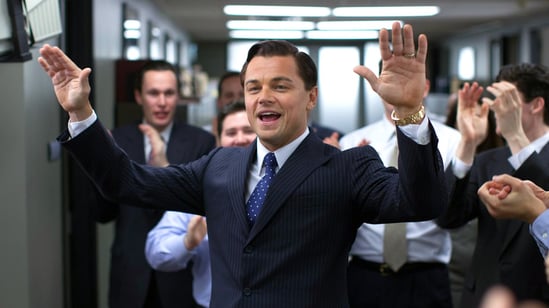The Wolf of Wall Street: A Symphony of Excess and the Price of Greed
Cinemapedia
Martin Scorsese’s The Wolf of Wall Street is a wild, unflinching exploration of ambition, excess, and moral decay. Released in 2013 and based on the memoir of Jordan Belfort, the film chronicles the meteoric rise and spectacular fall of a stockbroker whose life is fueled by greed and hedonism. With Leonardo DiCaprio delivering a career-defining performance, Scorsese crafts a film that is as entertaining as it is provocative.
The Rise and Fall of a Wall Street Tycoon
The narrative follows Jordan Belfort (Leonardo DiCaprio), a young, ambitious stockbroker who quickly discovers the corruptible power of Wall Street. Starting from penny stocks, Belfort builds a financial empire, Stratton Oakmont, by exploiting loopholes and manipulating investors. Alongside his partner Donnie Azoff (Jonah Hill), Belfort indulges in a lifestyle of unparalleled excess, marked by lavish parties, drugs, and debauchery.
However, as Belfort’s empire grows, so do the consequences of his actions. The FBI begins to close in, and his personal life spirals out of control. The story’s arc is a classic tale of hubris and downfall, rendered with Scorsese’s signature flair and dark humor.
A Frenetic Feast for the Eyes
The film’s visuals are as bold and unrestrained as its subject matter. Scorsese uses dynamic camerawork and rapid editing to immerse the audience in Belfort’s chaotic world. From opulent mansions to drug-fueled office parties, every frame pulsates with energy and excess.
One of the film’s standout sequences—Belfort’s quaalude-induced meltdown—is a masterclass in physical comedy and visual storytelling. The exaggerated, almost surreal presentation underscores the absurdity of Belfort’s life while maintaining a razor-sharp edge.
The Rhythm of Greed
The soundtrack is a carefully curated mix of classic rock, blues, and pop that captures the film’s irreverent tone. Songs like “Mrs. Robinson” by The Lemonheads and “Gloria” by Umberto Tozzi punctuate key moments, enhancing the narrative’s emotional impact.
The music’s eclecticism mirrors the film’s chaotic energy, serving as both a celebration and critique of the hedonistic lifestyle it portrays. It is a testament to Scorsese’s mastery of integrating music into storytelling.
The Seduction and Consequences of Greed
The Wolf of Wall Street is a biting critique of unchecked ambition and the corrupting influence of wealth. While the film revels in the absurdity of Belfort’s lifestyle, it does not shy away from showing the consequences of his actions. The destruction of relationships, the exploitation of others, and the eventual collapse of his empire serve as a stark reminder of the cost of greed.
At its core, the film poses a question: Is the pursuit of wealth worth the price of one’s soul? Scorsese’s refusal to provide easy answers makes the story all the more compelling, leaving viewers to grapple with their own interpretations.
A Bold and Unapologetic Masterpiece
The Wolf of Wall Street is a tour de force that showcases Scorsese’s unparalleled ability to blend humor, drama, and moral complexity. It is a film that entertains and provokes in equal measure, offering a scathing indictment of greed while reveling in its excesses.
With unforgettable performances, dazzling visuals, and a narrative that oscillates between comedy and tragedy, The Wolf of Wall Street stands as a modern classic. It is a cautionary tale for the ages, reminding us of the seductive and destructive power of unchecked ambition.


